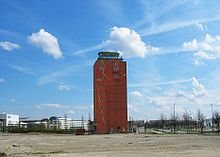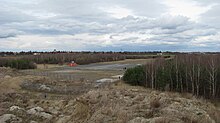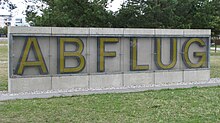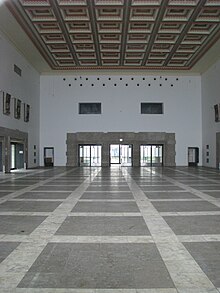Munich-Riem Airport
| Munich-Riem Airport | |
|---|---|

|
|
| Characteristics | |
| ICAO code | EDDM was reassigned to Munich Airport Franz Josef Strauss |
| IATA code | MUC was reassigned to Munich Franz Josef Strauss Airport |
| Coordinates | |
| Height above MSL | 530 m (1739 ft ) |
| Transport links | |
| Distance from the city center | 10 km east of Munich |
| Street | Federal motorway 94 |
| Local transport | S-Bahn , bus |
| Basic data | |
| opening | 1939 |
| closure | May 16, 1992 |
| operator | Munich Airport GmbH (FMG) |
| Terminals | 2 |
| Passengers |
11,423,838 (1990) |
| Air freight | 61,221 (1990) |
| Flight movements |
191,856 (1990) |
| Capacity ( PAX per year) |
12 million |
| Runways | |
| 07R / 25L | 2804 m × 60 m concrete |
| 07L / 25R | 814 m × 20 m concrete |
The Munich-Riem Airport from 1939 until its closure on 16 May 1992, the international airport of the Bavarian state capital Munich .
As early as 1954, it was recognized that the airport, which is only ten kilometers from downtown Munich, was reaching its capacity limits and could not be expanded. In 1992, the Riem Airport was replaced by the then newly built Munich Airport "Franz Josef Strauss". With the exception of the tower and the listed "Wappenhalle", the buildings of the former airport were largely demolished. Today, the area includes the trade fair city of Riem with residential and business complexes, the New Munich Trade Fair Center and the Riemer Park , which emerged from the Federal Garden Show 2005 emerged.
Location and transport links
Munich-Riem Airport was located about ten kilometers east of Munich city center in the Trudering-Riem district . The airport site was tangentially touched by the federal motorway 94 and the federal highway 471 , and the streets An der Point and Paul-Henri-Spaak-Strasse led to the airport. About one kilometer from the airport is the Riemer Bahnhof , which is connected to the Munich S-Bahn .
history
Opening and first years
Shortly after the Oberwiesenfeld airfield had started operations, it became apparent that this would not be sufficient for air traffic, as its surroundings made expansion impossible. In 1936 a place south of Riem was selected as the location for the new airport and planning by the architect Ernst Sagebiel , who was also responsible for the Tempelhof , Dresden and Stuttgart airports , which were being built at the same time, was started. Construction began in 1937. The opening was planned for September 1, 1939, when the airport was one of the most modern airports in the world. Due to the outbreak of the Second World War , the start of operations was delayed until October 25, 1939, when the first civil flight was carried out with a Junkers Ju 52 / 3m from Lufthansa from Berlin. One of the “special incidents” of this time was the departure of Adolf Hitler in his Focke-Wulf Fw 200 driver plane on November 11, 1939, three days after Georg Elser's attempted assassination had failed.
During the Second World War, Munich-Riem was the airfield of the Luftwaffe and was repeatedly the target of bombing attacks . However, civil aviation continued, the only airlines represented at the location were Swissair and Lufthansa. Civil air traffic did not end until April 9, 1945, when the airport facilities were almost completely destroyed in bomb attacks. After the occupation by the Americans, the airport was given the allied code designation Airfield R.82 .
post war period
On March 9, 1948, the Office of Military Government for Germany and the Free State of Bavaria agreed to resume flight operations in Riem, a Douglas DC-3 from Pan American World Airways was the first airliner to arrive on April 6, 1948 from London to Riem, after the end of the war it was the first airport in Germany that was completely usable again for civil aviation. On May 25, 1948, the Munich city council decided to guarantee operations, whereupon a contract was signed with the Office of Military Government for Germany on June 22 of the same year and the city of Munich on November 9, 1948, under the direction of the US flight administrator Charles D. Daily actually took over flight operations. The United States Air Force left the airport on May 30, 1948 . On May 6, 1948, the Dutch KLM Royal Dutch Airlines started operating after Pan Am and headed for Stuttgart and Amsterdam from here. The airport operating company Flughafen München-Riem GmbH was founded on October 12, 1949 by the equal shareholders of the City of Munich and the Free State of Bavaria, after a contract had previously been concluded between the Office of Military Government and the shareholders on the operation of the airport on April 1 of the same year was. Wulf-Dieter Graf zu Castell was appointed managing director, who held this post until 1972. Also in that year, an expansion of the runway to 1907 meters long and 60 meters wide was tackled, which was completed on November 22nd.
In 1951 the age of transatlantic flights began with a scheduled flight of KLM Royal Dutch Airlines to New York City, which was operated with a Lockheed Constellation , and the new reception hall was also put into operation on August 16 that year. On October 1, 1953, the first forces of the United States of America withdrew from Riem. Lufthansa began flight operations on April 1, 1955 with a scheduled flight from Munich-Riem to Hamburg.
The beginning of the jet age
In December 1956, Munich-Riem Airport was part of an airlift. The US Air Force's Military Air Transport Service (MATS) brought refugees from Hungary to the United States. Among other things, a Lockheed Constellation of US President Dwight D. Eisenhower was used, which also acted as Air Force One . On February 6, 1958, an Airspeed AS.57 Ambassador crashed during take-off on BEA flight 609 . Among the 23 dead were several Manchester United football players . In order to enable the use of jet aircraft , the expansion or extension had already been decided on October 4, 1957. Construction began on March 24, 1958; operations started on October 29, 1958. On the same day ended with a Sud Aviation Caravelle of Air France 's first jet airliner in Munich, the first scheduled flight of a jet aircraft is recorded on 16 May 1959 connection from Scandinavia via Munich to the Middle East by SAS Scandinavian Airlines , which is also with a Sud Aviation Caravelle. On December 7th of the same year, a Boeing 707 landed in Riem for the first time .
The plane crash of December 17, 1960 was the most momentous to date: after an engine failure during take-off, a Convair C-131D Samaritan of the US Air Force brushed the top of the main tower of St. Paul's Church and crashed into a fully occupied tram on Martin-Greif-Strasse; all 20 people on board and 32 people on the ground lost their lives.
In 1962, for the first time, more than a million passengers were handled in one year. The “Oechsle Commission” began looking for a new location for the airport in 1963, since several communities in the area would have had to be completely relocated in addition to the existing facilities in order to build new runways. In addition, several accidents led to the decision to build a new airport further outside the city and to close Riem.
In October 1965, a ten million D-Mark maintenance hangar for jet aircraft went into operation and was handed over to Lufthansa.
development
In 1969 Flughafen München-Riem GmbH was renamed Flughafen München GmbH and the runway 07R / 25L was further expanded to its final length of 2804 m. In 1971 the new arrival hall went into operation and the number of passengers exceeded the four million mark.

In its last full year of operation in 1991, 10.8 million passengers were handled at the old location, and in 1992 the mark of 12 million passengers (old and new location) was exceeded at Munich Airport. Munich-Riem Airport had long since reached its capacity limit. An expansion of the airport and an efficient runway system were not possible due to lack of space; Flight operations could only be managed through provisional terminal extensions and a hall specially set up for handling charter flights.
On May 17, 1992, the entire airport operations moved overnight to the newly built Munich Franz Josef Strauss Airport in Erdinger Moos near Freising . A Boeing 737 from Deutsche Lufthansa (D-ABJD, "Freising"), which took off on May 16, 1992 at around 10.55 pm for Berlin, was the last aircraft to take off from Riem. Munich-Riem Airport was shut down on May 16, 1992 at midnight, the previous airport codes MUC / EDDM were transferred to the new airport.
Reuse
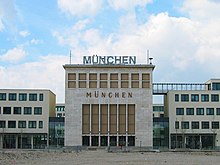
Cultural center
After the end of flight operations, Wolfgang Nöth and Jürgen Birr aka "Anurakta" ( Sannyas name), Theatron maker and former operator of the Powder Tower Club on the former Alabama depot site, took over the airport site for temporary use as a cultural center . Numerous large events such as concerts and raves were held in the terminal buildings such as the Zeppelin Hall (Hit FM Hall), Charter Hall , Terminal 1 and Wappensaal , and flea markets on the old runway . The former Riem airport was internationally known, especially in the techno and alternative rock scenes.
From August 27th to 29th, 1993, the three-day open-air festival Rock over Germany with many international stars such as Prince , Tina Turner , Rod Stewart , Chris de Burgh , Foreigner and many other artists took place on the former runway . Despite the bad weather, over 185,000 fans came to the former airport grounds for this event. Persistent rain had softened the meadows away from the paved areas to such an extent that the visitors were sometimes up to their ankles in the mud. In Munich rubber boots, raincoats, umbrellas etc. were as good as sold out at the weekend.
On March 1, 1994, the last concert of the band Nirvana took place in the former Terminal 1 . On June 17, 1994, the Techno-Club Ultraschall opened in the former large kitchen of the airport . Also in 1994, the Großrave Universe Rave - Tribal Gathering took place in the airport halls for the first time in Germany . In the same year Rock in Riem , today's Rock im Park , was held on the airport grounds.
On March 4, 1995, the first Rave City events were held in the airport halls . International DJs and live acts from various branches of the techno and house scene performed at this large rave, including Westbam, Sven Väth, Komakino, Steve Mason, Hardsequenzer, Ravers Nature, Tanith, Mark Spoon, Paul van Dyk, Aural Float, Grooverider, Hype, Ray Keith, David Morales, Armand van Helden.
The cultural center was closed in the summer of 1996 and replaced by the Kunstpark Ost (today's Kultfabrik ), as the area was needed for the Messestadt Riem .
Messestadt Riem
The redesign of the airport grounds into the Messestadt Riem with residential, office and business units as well as the new exhibition grounds and green spaces was one of the largest urban planning projects in the state capital of Munich in the late 1990s and early 21st century.
In 2005 the Federal Garden Show took place on the former airport site.
Remaining facilities
Today only the listed tower building ⊙ and the coat of arms hall ⊙ , the former terminal building, are reminiscent of the airport. There is also a 65 by 80 meter piece of the former runway ⊙ at the eastern end of the Riemer Park and the airport grandstand Trib and the departure sign ⊙ to the west . A plaque commemorates the accident on BEA flight 609 ⊙ . Part of the interior of the tower, such as radar screens, can now be seen in the German Museum in the aviation department. On the main site of the Technical University of Munich , two passenger bridges have been installed as building crossings. The remaining parts of the old airport are spread over the entire area of today's trade fair city and are all easily accessible, although sometimes difficult to find.
In May 2018, it became known that the connecting joints between the head building, which had been vacant for years, and the grandstand were infected with mold.
After the neighboring airport buildings were demolished, the tower was a free-standing, largely unused building for around twenty years. At the beginning of 2015, Brainlab AG and the Munich project developer Wöhr + Bauer agreed to develop the fallow area, including the historic tower. In November 2014, construction began both on the approximately 25,000 square meter office building and on the tower, which was upgraded under strict conditions of the monument protection authorities and modernized and redesigned inside. Since the opening of the new headquarters of Brainlab AG in July 2017 by Chancellor Angela Merkel , the various areas of historical walls have been officially used. In the tower there is an employee café, two fully functional operating theaters, a conference room extending over two floors, a yoga room, various lounges, a night club and a roof terrace on the 10th floor. The premises are primarily used by the employees of Brainlab AG themselves - on a few days a year, however, there is also the possibility for external companies to rent the event space in the tower. The tower is marketed under the registered brand name The Brainlab Tower and can also be found under this name as a "place" in various map services.
Today Riem Airport is part of the Trudering-Riem Cultural History Trail .
Incidents
- On December 22, 1956, a Convair CV-340 of Jugoslovenski Aerotransport ( aircraft registration YU-ADA ) crashed while approaching the airport near the village of Grub . Of the 30 inmates, three were killed.
- On February 6, 1958, after a refueling stop in Munich-Riem, an Airspeed AS.57 Ambassador of British European Airways (G-ALZU) , which was on a charter flight from Belgrade to Manchester , had an accident . The machine came off the runway on its third attempt to take off and went up in flames, presumably slush on the runway prevented it from reaching the required speed. Here, 23 of the 44 people on board died, including eight football players of Manchester United (see also British European Airways Flight 609 ) .
- On December 17, 1960, an American military aircraft of the type Convair C-131D Samaritan of the United States Air Force (55-0291) , which had taken off from Riem Airport and could not gain altitude quickly enough due to an engine failure, grazed the Top of the main tower of the Paulskirche in Munich and fell on a tram at the nearby Martin-Greif-Straße . The accident resulted in 52 deaths - the 20 aircraft occupants and 32 tram passengers and passers-by (see also the plane crash on December 17, 1960 in Munich ) .
- On January 20, 1968, the nose landing gear of a Douglas DC-7B operated by Transair Sweden (SE-ERC) collapsed during landing at Munich-Riem Airport . The machine leased to Türk Hava Yolları (THY, now Turkish Airlines) fell off the runway. All 38 occupants (6 crew members and 32 passengers) were uninjured. The aircraft was damaged beyond repair.
- On February 10, 1970, during a stopover on an El Al line flight to London, an attack by Palestinian bombers broke out. The three assassins broke into the transit room, where the crew and passengers were at the time, and tried to get those present under their control. There was a fight. Before the assassins could be overpowered by the crew and passengers, they detonated two hand grenades. They killed an Israeli passenger, Arie Katzenstein, who had tried to use his body to protect the others from the grenade, and they injured nine other people, some seriously. In September the assassins were deported to the Arab region without any legal proceedings in Germany. The Bavarian state government, as the authority responsible for the public prosecutor's office, was led by Alfons Goppel at this time .
- On July 31, 1982, seven people were seriously injured in a bomb attack in a lobby used for handling travelers to Israel .
- On February 5, 1987 a Swearingen Merlin IV of the RFG - Regionalflug (D-IEWK) coming from Dortmund was flown well below the prescribed decision height on approach in bad weather . The very late and deep go- around resulted in a belly landing . After sliding around 300 m and after the main landing gear had collapsed, the machine came to a standstill in a snow-covered field a good 150 m from the runway. All 16 occupants survived the total write-off.
- On August 11, 1987, a Piper PA-31T "Cheyenne II" (D-ILRA) crashed near the airport. A total of 9 people died in this accident (see also plane crash in Trudering ) .
Traffic figures
| Year of operation | Passenger volume | Air freight [ t ] | Flight movements |
|---|---|---|---|
| 1950 | 69,044 | 1,273 | 5,332 |
| 1960 | 794.613 | 7.506 | 50,108 |
| 1970 | 3,550,929 | 31,943 | 102.907 |
| 1980 | 6,057,997 | 39.091 | 142.032 |
| 1990 | 11,423,838 | 61,221 | 191,856 |
Airport races
At the beginning of the 1950s, Munich-Riem Airport was a well-known venue for major motorsport events . The flight operations were still very manageable and so the "Riemer circuit races for motorcycles and racing cars" could be held on a racetrack bordered by straw bales in the middle of the apron. 80,000 spectators followed on 2/3 May 1951 the 45 laps and 103.5 km championship run of the "Formula II class racing cars up to 2000 ccm", in which the racing legends Hans Stuck (Grainau) and Fritz Riess (Nuremberg) competed with their AFM racing cars .
literature
- Ralph D. Hildebrand, Rainer Wallbaum: The Munich Airport. A work of the century . Leo, Munich 1992, ISBN 3-928935-00-3 (three volumes).
- Ingo Anspach: Like in flight. The 50 year history of Flughafen München GmbH . Piper, Munich 1999, ISBN 3-492-04071-3 .
- Mathias Irlinger: "Stadium of Aviation". The Munich-Riem Airport between urban representation and National Socialist urban politics , in: Margit Szöllösi-Janze (ed.): Munich in National Socialism. Image policy of the “capital of the movement”. Wallstein, Göttingen 2017, pp. 217-240, ISBN 978-3-8353-3090-0 .
Web links
- Munich Riem Airport online museum
- The mammoth parade from Munich
- The old Munich-Riem Airport: what can still be seen 25 years later
- Looking for traces in Riem
- Munich-Riem - A gate to the world is closed
Individual evidence
- ↑ a b Ingo Anspach: As if in flight . Piper, Munich 1999, ISBN 3-492-04071-3 , pp. 7 .
- ↑ a b Ingo Anspach: As if in flight . Piper, Munich 1999, ISBN 3-492-04071-3 , pp. 32 and 33 .
- ↑ Aircraft accident data and report of the accident of December 17, 1960 in the Aviation Safety Network (English)
- ↑ Ingo Anspach: As if in flight . Piper, Munich 1999, ISBN 3-492-04071-3 , pp. 60 and 61 .
- ↑ Munich Airport online museum. Last flight from Munich Riem Airport [1]
- ↑ Wolfgang Nöth - A dog is scho SCHO! (PDF file; 485 kB), freshguide 12/2008.
- ↑ a b c Mirko Hecktor, Moritz von Uslar, Patti Smith, Andreas Neumeister: Mjunik Disco - from 1949 to today . Blumenbar Verlag, Munich 2008, ISBN 978-3-936738-47-6 .
- ↑ a b c Anja Schauberger: Club Legenden # 4: Raves and Nirvana's last concert at Riem Airport. In: With pleasure. February 2017, accessed May 6, 2020 .
- ↑ 10 legendary techno parties that we missed. In: Faze magazine . November 1, 2019, accessed June 5, 2020 .
- ↑ Carmen Ick-Dietl: Old airport grandstand infested with mold - does an FCB star help? “There are talks”. In: www.merkur.de. May 22, 2018, accessed June 16, 2018 .
- ↑ The tower is sold. Evening newspaper , February 25, 2015, accessed on December 28, 2015 .
- ↑ Medical technology company: Merkel inaugurates new Brainlab headquarters in Munich . ( handelsblatt.com [accessed September 21, 2017]).
- ↑ Alfred Dürr: Where airplanes used to take off, high-tech is now emerging . In: sueddeutsche.de . July 11, 2017, ISSN 0174-4917 ( sueddeutsche.de [accessed on September 21, 2017]).
- ↑ google.de: The Brainlab Tower
- ^ Accident report YU-ADA, Aviation Safety Network (English), accessed on June 25, 2016.
- ^ Accident report G-ALZU, Aviation Safety Network (English), accessed on June 25, 2016.
- ↑ Link to the news broadcast of February 14, 1958 on the aircraft accident
- ^ Accident report DC-7B SE-ERC , Aviation Safety Network (English), accessed on March 14, 2019.
- ↑ to the complex Wolfgang Kraushaar : “When will the fight against the holy cow Israel finally begin?” Munich 1970: on the anti-Semitic roots of German terrorism. Rowohlt, Reinbek 2013 ISBN 3-498-03411-1
- ^ Accident report SWM Merlin IV D-IEWK, Aviation Safety Network (English), accessed on June 25, 2016.
-
↑ filmothek.bundesarchiv.de :
* world in the film 211/1949 June 10, 1949: "3b. Munich: Flugfeldrennen “
* Welt im Film 310/1951 May 11, 1951:" 5a. Munich Riem: Flugplatzrennen


